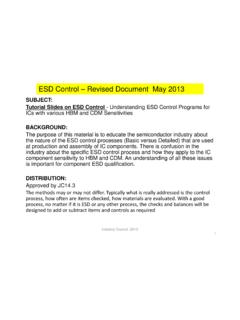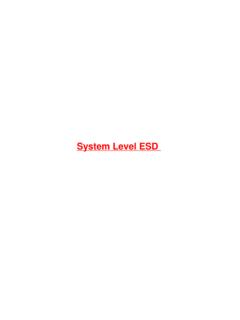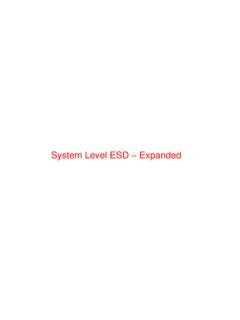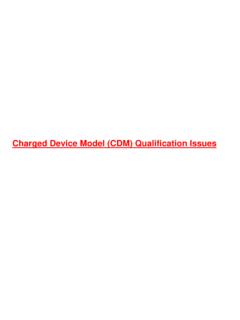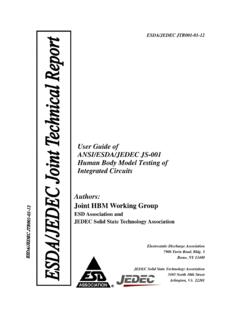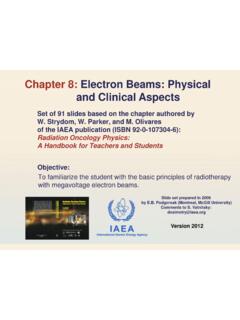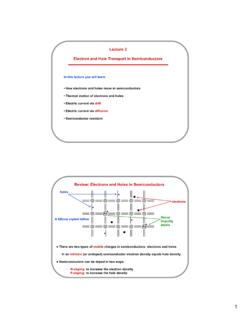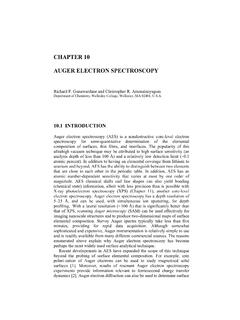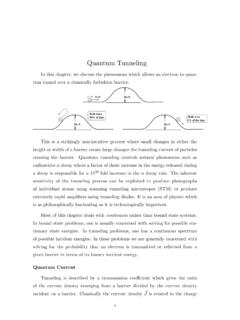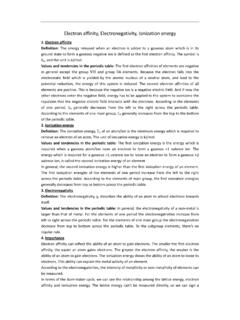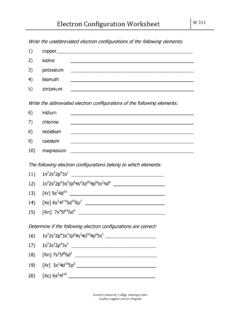Transcription of JEDEC SSD Specifications Explained
1 JEDEC SSD Specifications ExplainedAlvin Cox, SeagateChairman, SSD Standards JESD218, Solid State Drive (SSD) Requirements and Endurance Test Method JESD219, Solid State Drive (SSD) Endurance WorkloadsWhat do these standards include? SSD Requirements SSD Definitions SSD Capacity Application Classes Endurance Rating Endurance Verification SSD Endurance Workloads Client EnterpriseScope of JESD218 Define JEDEC requirements for SSDs, classes of SSDs, and the conditions of use and corresponding endurance verification requirements. The standard is sufficient for the endurance and retention part of SSD qualification.
2 Developed for SSDs with NAND Documents JESD22-A117, Electrically Erasable Programmable ROM (EEPROM) Program/Erase Endurance and Data Retention Stress Test JESD47, Stress-Test-Driven Qualification of Integrated Circuits JEP122, Failure Mechanisms and Models for Semiconductor Devices JESD219, Solid State Drive (SSD) Endurance WorkloadsKey Definitions Endurance failure A failure caused by endurance stressing. Endurance rating (TBW rating) The number of terabytes that may be written to the SSD while still meeting the Definitions Erase block The smallest addressable unit for erase operations, typically consisting of multiple pages.
3 Page A sub-unit of an erase block consisting of a number of bytes which can be read from and written to in single operations, through the loading or unloading of a page buffer and the issuance of a program or read Definitions Program/erase cycle The writing of data to one or more pages in an erase block and the erasure of that block, in either order. Retention failure A data error occurring when the SSD is read after an extended period of time following the previous Definitions Solid state drive A solid state drive (SSD) is a non-volatile storage device. A controller is included in the device with one or more solid state memory components.
4 The device should use traditional hard disk drive (HDD) interfaces (protocol and physical) and form Definitions Unrecoverable Bit Error Ratio (UBER) A metric for the rate of occurrence of data errors, equal to the number of data errors per bits read. Key Definitions Write amplification factor (WAF) The data written to the NVM divided by data written by the host to the of HDDs and SSDsExample: 70GB, TBW rating = Rewrites# corrupt sectors per drive SSDHDDTBW ratingUBER ratingMaterial submitted by IntelUBER equality questionExample: 70GB, TBW rating = Rewrites# corrupt sectors per drive SSDHDDI nstantaneous UBER for the spec limit is when dx/dtof SSD UBER = dx/dtof constant UBER =Specification limit ( , slope of tangent line to curve equals that of a constant UBER over life slope)Does allowing the limit to intersect the constant line result in a much worse UBER at that point in time than the specification limit?
5 UBER Lifetime-average is the standard in reliability (may be more familiar by its equivalent name, cumulative % fail). Instantaneous slope is not used as the basis for qualification. Lifetime average is in the draft because it is the most accurate value to use and the most consistent with prior determination Although the UBER concept is in widespread use in the industry, there is considerable variation in interpretation. In this JESD218, the UBER values for SSDs are lifetime values for the entire population. The numerator is the total count of data errors detected over the full TBW rating for the population of SSDs, or the sample of SSDs in the endurance verification.
6 A sector containing corrupted data is to be counted as one data error, even if it is read multiple times and each time fails to return correct data. The denominator is the number of bits written at the TBW rating limit, which aligns to the usual definition of errors per bit read when the read:writeratio is Write amplification factor (WAF) The data written to the NVM divided by data written by the host to the SSD. An SSD usually writes more data to the memory than it is asked to write. The nature of the workload plays a significant Factors that impact WAF: Sequential versus random Large transfers versus small ones Boundary alignment Data content/patterns (especially for SSDs using data compression)WAF example Because NAND can only be written to after having been erased, and the granularity of erasure is coarse (referred to as the Erase Block), some NAND management algorithms can result in a large amount of data being written to NAND for a modest amount requested to be written by the host.
7 The multiplication factor that describes how much larger the ultimate write to the NAND becomes is known as write amplification. For example, if a host write of 4KB results in a write to the NAND of 16KB, then the write amplification is 4. Material submitted by IntelWAF exampleMaterial submitted by IntelThe figure shows one NAND block comprised of 64 pages. For this example, assume that each page is 2KB in size (four sectors) giving a total of 256 sectors per block. This block has valid host data in all of its pages. Assume that the host writes only some pages in this block with new data as illustrated on the next slide.
8 WAF exampleMaterial submitted by IntelIn NAND, before programming a page it has to be first erased and the erase granularity in NAND is in blocks. Therefore to program the 8 sectors shown in yellow in Figure 2 above, one possible approach is to use a read/modify/write algorithm as follows: entire block (page 0 to page 63) to DRAM. pages 1, 2 and 3 with the new data that the host wants to write. DRAM now has the block as shown in the figure with the new Host data. the block in the NAND. the block with the data from DRAM. (This is equivalent to writing 256 sectors in the NAND.)
9 With this implementation, a host write of 8 sectors resulted in a NAND write of 256 sectors. The write amplification for this example is 32 (256/8). WAF exampleNote that had the example above used a larger transfer that spanned the entire erase block (or sequential transfers that could be internally buffered in the SSD to fill the entire erase block) that the write amplification would essentially be 1 since the entire erase block would have new data to be written. The nature of the workload has substantial impact on resulting write amplification and in general small random writes tend to create the largest write amplification submitted by IntelSSD capacity SSD Capacity in Gbytes= (User-addressable LBA count -21168) / 1953504 Same value as IDEMA for HDDs except no 50GB limit Requested by OEMs for ease of implementation (HDD or SSD) This version for 512 byte sectors 4k sector version in developmentApplication classes Current application classes: Client Enterprise Application classes attributes.
10 Workload Data retention BERE ndurance rating Establish a rating system for comparing SSDs. Provides unique rating for application class. Rating based on a user-measurable interface activity: TBW. TBW = TeraBytesWritten. Decimal value to be consistent with user ratingThe SSD manufacturer shall establish an endurance rating for an SSD that represents the maximum number of terabytes that may be written by a host to the SSD, using the workload specified for the application class, such that the following conditions are satisfied: 1) the SSD maintains its capacity;2) the SSD maintains the required UBER for its application class;3) the SSD meets the required functional failure requirement (FFR) for its application class.
